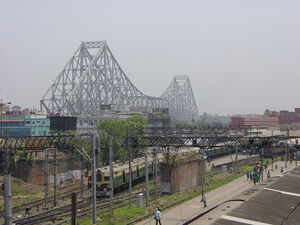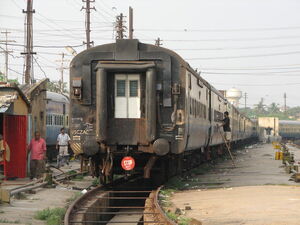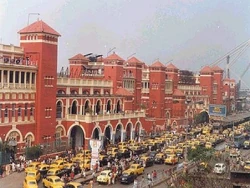| STATION Howrah Terminus | |
|---|---|
| Location: | Howrah, West Bengal |
| Lines: | Howrah - Delhi Howrah - Mumbai Howrah - Chennai Howrah - Guwahati |
| Connections: | Taxi Stand, Ferry Ghat, Bus Stand and Trams |
| Structure: | Standard (On Ground Station) |
| Platforms: | 23 |
| Tracks: | 25 |
| Parking: | Available |
| Flyovers: | 0 |
| Baggage Check: | Available |
| Opened In: | 1954
|
| Electrified: | 1954 |
| Station Code: | HWH |
| Owned By: | Eastern Railway |
| Formerly Owned By: | East India Railway, till 1947 |
Howrah Station is one of the four intercity terminii serving Howrah and Kolkata, the others are Sealdah, Shalimar and Kolkata Terminus in Kolkata. Howrah is situated on the West bank of the Hooghly River, linked to Kolkata by the magnificent Howrah Bridge which is an icon of Kolkata. It is the second-oldest station and one of the largest railway complexes in India.
History

The first train from Howrah to Hooghly in 1854
In 1854 the British India started building a rail link from Kolkata to the coalfields in Barddhaman district. This was the second railway line constructed in India after the first one from Mumbai to Thane in 1853. The line started from Howrah, then a small town on the west shore of the Hooghly River.
Initial plans for the first Howrah station were submitted by George Turnbull, the Chief Engineer of the East Indian Railway Company on 17 June 1851. In January 1852, it became clear that the government authorities would not sanction the purchase of sufficient land nor the necessary waterfrontage despite remonstrations from Turnbull that the terminus would grow enormously. In May 1852, the detailed station plans were the major work of him and his team of engineers. In October four tenders for building the station were received varying from 190,000 to 274,526 rupees against an estimate of 250,000 rupees.[1][2]
Due to a great increase of traffic, a new station building was proposed in 1901. The new station was designed by the British engineer Halsey Ricardo. It was brought into service on 1 December 1905. This building is the current Howrah station building. The station had 15 platform tracks then.
It was expanded in the 1980s with the addition of 8 platform tracks in an area to the south of the station which previously had a parcels terminal, bringing the track count up to 23. At the same time a new Rail Yatri Niwas (transit passenger facility) was built south of the original head house.
Platforms
Howrah Station is slated to get an additional 15 platform tracks north of the current station in the next decade to bring it up to a total of 37 platform tracks.
The station is served by the Eastern Railway for trains to Belur Math, Tarakeshwar, Katwa and Barddhaman, and points north along the Ganges. A narrow gauge line connects Barddhaman and Katwa and served by DMU trains (all other lines run EMU trains). There is a plan to extend the suburban train service from Bardhaman to Mankar and Guskara, by electrifying the Khana - Guskara existing stretch, which is currently served by diesel loco hauled trains. The Barddhaman - Mankar stretch is now electrified. The South Eastern Railway for trains to Amta, Haldia, Digha and Kharagpur. The Tamluk - Kanthi stretch is currently under electrification and until complete, it will be served by DMU trains (all other lines run EMU trains). There is a plan to extend the suburban train service from Kharagpur to Jhargram and Kharagpur to Narayangarh. Both stretches are now electrified.
Services
Trains from this station serve the Kolkata urban area via the Kolkata suburban railway, the state of West Bengal, and most major cities of India. Its twenty-three platforms handle over three hundred trains each day, serving more than a million passengers. It is served by two zones of the Indian Railways: Eastern Railway and South Eastern Railway.
The station operated by the Eastern Railway.
South Eastern Railway was previously known as the Bengal Nagpur Railway (BNR, derisively called "Be Never Regular" because of its notorious tardiness) which built the truck route from Kolkata to Nagpur connecting to Great Indian Peninsular (GIP) route to Mumbai and the trunk route to Vijayawada connecting with the GIP route to Chennai. Eastern Railway was previously known as East Indian Railway (EIR) which built the trunk route from Kolkata to Delhi Jn..
Four of India's most important trunk rail routes end in Howrah. They are Howrah - Delhi, Howrah - Mumbai, Howrah - Chennai and Howrah - Guwahati. Today there are 23 platforms in Howrah. The first Rajdhani Express in the country ran between Howrah and New Delhi in 1969. Eastern Railway handles trains for northern, north-western, north-eastern & eastern India through Barddhaman line & Katwa line. South Eastern Railway handles trains for southern, south-western, south-eastern, western & central India through Kharagpur Line. Kanthi line is also serving long distance intra-state trains.
The Eastern Railway and South Eastern Railway section is connected by two links, one is Liluah -Tikiapara link , and other is Rajchandrapur/Dankuni - Kona link , but both links are used by only goods trains. There are proposals to introduce passenger train service on these two links to quickly travel between the two sections avoiding Howrah.
Facilities

Suburban Train leaving Howrah
Howrah houses the divisional headquarters of the Howrah Division of Eastern Railway.
For passengers it has an enormous covered waiting area between the head house and the platforms. The head house has waiting rooms and retiring rooms for use by passengers awaiting connecting trains. In addition there is a Rail Yatri Niwas which provides dormitory accommodation for passengers awaiting connections.
North of the station there is now a new Railway Museum displaying artifacts of historical importance related to the development of Eastern Railway.
In addition the station complex includes the following:
- Diesel Loco shed (55+ locos)
- Electric Loco Shed (75+ locos). Also has an electric trip shed with a capacity to hold around 15-20 locos
- EMU Car Shed (15+ parking slots)
- Coach Maintenance Complex servicing consists of many prestigious trains like the Rajdhani and Shatabdi Expresses.
South Eastern railway's EMU carshed and electric loco shed are situated respectively at Tikiapara and Santragachhi.

Railway Yard at Howrah
Before 1992, there was a tram terminus at Howrah station. Trams departed from here towards, Sealdah, High Court, Dalhousie Square, Park Circus and Shyambazar. Trams also departed from here towards Bandhaghat and Shibpur. That terminus was partially closed in 1971 for closure of Bandhaghat line and Shibpur line. Many unauthorised vehicles and peoples captured the tram track carrying streets and it was impossible to continue tram service on these routes. State government was more interested to close these lines rather than control buses, taxis, rickshaws and people for free moving of trams. After these closure, the part of the terminus which served those two lines was re-constructed for underpasses and bus terminus. But the other part was still functioned up to 1992, when it was proved that the Rabindra Setu (Howrah Bridge) is not fit for carrying tram service, because it is a cantilever bridge. So although the inauguration of the bridge was occurred by opening the tram track on it, the line on the bridge was closed in 1992. Previously route 11, 20, 26, 30 & 32 served this terminus. Now the terminus is used by buses, and all trams for Howrah station are now departed from Barabazar (1 km away). Some stretches of tracks and masts are still present.
When the Kolkata Metro line 2 would built, it will pass through Howrah.
